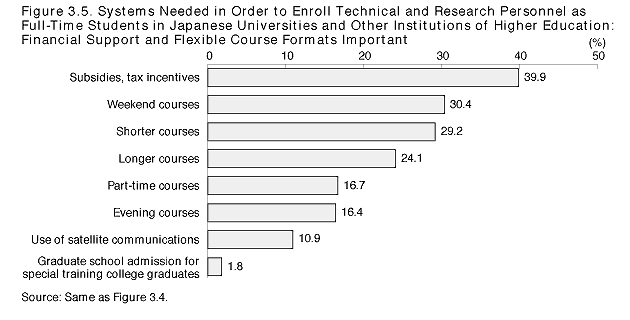| Home > Policy > White Paper, Notice, Announcement > White Paper > JAPANESE GOVERNMENT POLICIES IN EDUCATION, SCIENCE, SPORTS AND CULTURE 1996 > Priorities and Prospects for a Lifelong Learning Society Chapter 3 Section 2 4 | ||
Learning opportunities provided by institutions of higher education tend to be concentrated in the institutions' immediate geographical area. As a result there are regional disparities in access to learning opportunities. This problem is not limited to institutions of higher education but characterizes all kinds of structured, ongoing learning at advanced levels.
As discussed in section 1, one solution to this regional disparity in access is the speedy expansion of the University of Air to provide nationwide coverage. There have also been moves to use satellite communications to enable adult students to take university courses in the workplace and elsewhere. These efforts should be continued and expanded. In fiscal 1996 MESSC initiated the Project to Promote the Development of an Advanced Learning System for Citizens' Public Halls Through the Use of Communications Satellites. This project is now studying the possibility of using satellites to transmit extension course programs from universities and other institutions of higher education to citizens' public halls.
Participation in structured, ongoing learning activities at institutions of higher education requires a certain continuous period of time; financial resources are also an important consideration. According to the 1996 MESSC survey, the majsority of people studying at such institutions found tuition fees and other costs a burden ( Figure 2.25 ). The percentages of people citing lack of time owing to work or inadequate financial resources as reasons for not advancing to higher levels of learning were far higher among those studying at graduate schools, universities, and special training colleges than among those using other learning methods ( Figure 2.13 ).
The most frequent response given when respondents were asked to indicate the most essential requirement for continuing with their present method of learning or advancing to a higher level was "access to courses at lower cost." This response was chosen by 19.5% of respondents at the graduate school level, 26.7% of those at the university level, and 26.9% of those studying at special training colleges."Financial support from employer" was the third most popular response at the graduate level (10.5%) and accounted for 6.1% of responses from people studying at universities. A similar pattern emerged in responses to this question from the time perspective. At the graduate level, for example, 9.1% of respondents cited "opportunities to learn at convenient times," while "adjustment of working hours to allow learning activities" attracted 7.7% of responses and "paid leave for learning activities" 7.1%. These figures were higher than those for other learning methods. A similar trend was seen emerged among people studying at universities ( Figure 3.1 ).
This tendency was confirmed by the results of the MESSC survey on refresher education. Employers were asked to list the systems that they considered most desirable from the viewpoint of sending technical and research personnel to study as full-time students at universities and other institutions of higher education. The leading responses were "subsidies, tax incentives" (39.9%) from the financial perspective and "weekend courses" (30.4%), "shorter courses" (29.2%), and "longer courses" (24.1%) from the time perspective ( Figure 3.5 ).
One solution to the problem of cost is improvement of scholarship systems. The problem of time can be overcome by further efforts to establish day/evening programs and evening graduate schools and through efforts to provide learning opportunities in ways that facilitate participation, such as the implementation of short-term intensive programs.

| Back to Top | MEXT HOME |